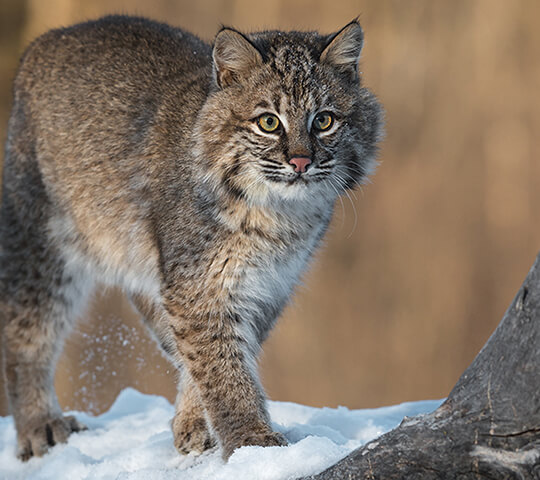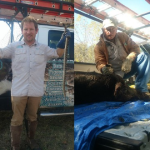With a range extending from northern Mexico through most of the continental United States, bobcats are an adaptable predator that can thrive in a variety of ecological systems—including near human residences. Sometimes twice the size of housecats, bobcats prey on a variety of smaller creatures. While they prefer rabbits and hares, they have also been known to hunt domestic cats and small dogs. Attacks on humans are rare. If you find a bobcat on or near your property, contact AAAC Wildlife Removal, your local animal control specialists.
Bobcats, with their stealthy movements and striking appearance, are an intriguing part of North American wildlife. Often mistaken for their larger cousin, the mountain lion, these mid-sized wildcats have earned a reputation in both urban and rural settings. Let’s explore the fascinating world of the bobcat.
Appearance
General Characteristics
Bobcats are robust animals with strong, muscular bodies. Their name is derived from their short, "bobbed" tail, which distinguishes them from other wildcats. Bobcats have tufted ears, which are a key feature, and long whiskers that help them navigate their environment.
Coloration/Patterns/Distinctive Markings
Bobcats usually possess a coat that is tan to grayish-brown with dark spots and stripes. This pattern helps them blend into their surroundings, making them excellent stealth hunters. Their belly is white, and they might have black-tipped ears with white patches on the back.
Size/Features
On average, adult bobcats weigh between 15 to 35 pounds, with males generally being larger than females. They measure about 18 to 49 inches in length, tail included. Despite their compact size, bobcats are powerful and agile.
Biology
Digestion and Diet
Bobcats are carnivores, primarily feasting on rabbits, birds, rodents, and even small deer. They utilize a keen sense of sight and hearing to stalk and ambush their prey, ensuring efficient energy use and digestion.
Reproduction
Bobcats mate in the early spring, and after a gestation period of about 60 days, the female will give birth to a litter of one to six kittens. These kittens stay with their mother for up to a year, learning essential hunting skills.
Unique Sensory Systems
Bobcats have incredible hearing and vision. Their large ears can rotate, allowing them to zero in on even the faintest of sounds – an essential tool for a predator. Their night vision is also exceptional due to a higher number of rod cells in their eyes.
Habitat
Preferred Environments
Bobcats are versatile animals that can adapt to various habitats. They prefer wooded areas, swamps, and semi-deserts, but they're also found in suburban areas where food is plentiful.
Urban Encounters
As humans encroach on their natural habitats, it's not uncommon for bobcats to be spotted in suburban yards or even on city fringes. They are typically drawn by the presence of prey, such as rabbits and rodents.
Temperature Regulation
Bobcats have a dense undercoat that helps them withstand colder temperatures during the winter months. In contrast, they can also tolerate the heat by becoming more nocturnal and resting during the hotter parts of the day.
Behavior
Defensive Mechanisms
When threatened, bobcats may hiss, growl, or bare their teeth. They prefer to avoid confrontation and will often retreat unless cornered or defending their young.
Hunting Techniques
Bobcats are ambush predators. They rely on stealth, patiently waiting for the right moment to pounce on their prey. Their sharp retractable claws and keen senses make them formidable hunters.
Migratory Patterns
Bobcats are generally territorial and do not migrate long distances. However, young males might travel in search of their own territory, sometimes covering significant distances.
Damage/Problems
Diseases
Bobcats can carry diseases like rabies, which is a concern when they come into close proximity with humans or domestic animals.
Burrowing
While not true burrowers, bobcats might dig or use existing dens for shelter or rearing their young.
Structural Damage
Bobcats can cause damage if they decide to take shelter under decks or in sheds. Their hunting behavior can also lead to the loss of domestic animals like chickens.
Trapping & Removal
Safe Handling
Trapping a bobcat requires knowledge and skill. They can be aggressive when threatened and should be handled by professionals.
Relocation
Relocating bobcats is often the best solution for both the animal and the homeowner. It's essential to release them in a suitable habitat, away from human habitation.
Deterrence or Prevention
Property Maintenance
Regularly maintaining your property, including clearing overgrown vegetation, can deter bobcats by removing potential hiding spots.
Physical Barriers
High fences (with a top angling outward) can help keep bobcats out of particular areas.
Exclusion
Secure all potential shelter areas like sheds or under-deck spaces. Also, securing domestic animals at night can deter bobcats from venturing close.
When it comes to dealing with a bobcat on your property, it's best to leave it to the experts. At AAAC Wildlife Removal, we understand the importance of coexisting with these majestic creatures while ensuring the safety of your home and loved ones. Our team of professionals is skilled at humane bobcat removal and can offer solutions to prevent future encounters. Contact us today for a consultation.



















































